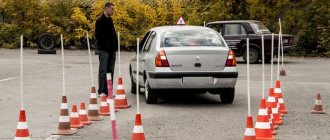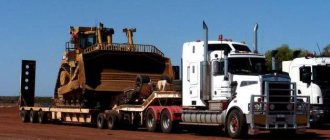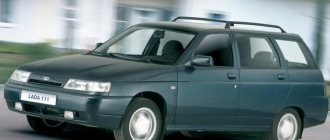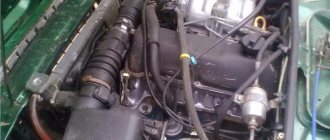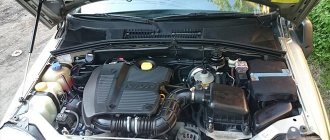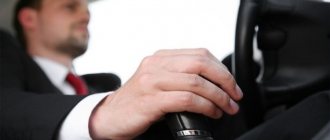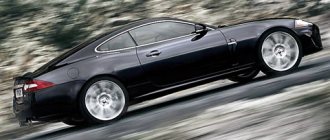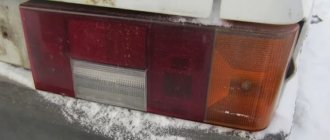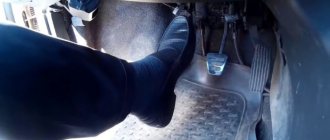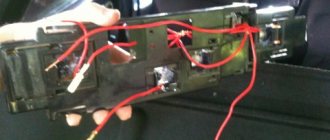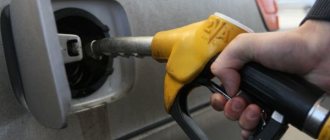To take into account the dimensions of your car on the road, it is not enough to memorize the dimensions of length, width and height in centimeters. You will have to learn to feel the distance from the driver's seat to the bumper and determine by eye how many meters from the body of your car to the next one. In order to learn how to navigate the space while driving and not make deadly mistakes, you should perform several exercises, and then you will feel like a fish in water in a crowded traffic flow.
How to understand the dimensions of a car - beginner mistakes
The problem of car feel is especially acute for drivers without experience. Beginners who have recently received a driver's license complain: they don't feel the size of the car. In the first year of their practice, motorists are faced with problems of parking and maneuvering in narrow areas: it is difficult for them to turn around in a small area, in limited conditions, among many other obstacles.
When I got behind the wheel for the first time, it seemed to me that I was sitting in the center, and to the right and left of me there was the same distance to the wheels. Until now, after 10 years of driving experience, probably, like many drivers, I feel better the left dimensions - along the driver's seat.
As you can see, first of all you should understand that there is a greater distance to the right wheel than to the left.
The second mistake beginners make is trying to see what is in front of the bumper, looking over the hood. For this reason, many novice drivers move the driver's seat closer to the windshield, resting against the steering wheel. Should not be doing that. The driver needs to look at the road, and not at the wheels. You will be able to feel the size of the car when you gain sufficient skill.
And one more piece of advice – the main thing is to learn how to use mirrors. In the mirror, it seems that neighboring cars are further away than in reality. You think that the car behind you is still far away, since it looks quite small in the mirror, but in reality it is just an optical illusion.
IT IS IMPORTANT TO KNOW. Side and rearview mirrors have a blind spot
A car's blind spot is the space around the car that is not reflected in the mirrors. The driver may not be able to see oncoming vehicles from his seat. Therefore, it is worth remembering that before starting a maneuver, you need to first look in the mirrors several times, making sure that it is safe.
Tips for beginners
The more time you devote to training, the better. It is impossible to feel the dimensions without proper practice, so you should not limit your studies only to lessons in a driving school. Professional drivers recommend that novice motorists adhere to the following recommendations:
- do not try to see anything under the wheels of the car while driving;
- Don't focus solely on the road ahead;
- take into account that in the side mirrors objects appear smaller than they actually are;
- Pay more attention to moving backwards during training.
You can learn how to drive safely only with an instructor. Self-study will allow you to consolidate and improve the acquired skills, so they cannot be ignored, but it is also inadvisable to refuse professional help. If you want to become a confident driver and enjoy your trips, sign up for courses at the Vector driving school.
Change lane training
How to learn how to putty car body parts with your own hands.
It will help you figure out how to feel the dimensions of a car by repeating the “parking in a confined space” exercise. Plastic tall objects come to the rescue. On an empty site, they imitate the lines of the curb and the dimensions of standing cars, between which you will have to squeeze. The best option, of course, is to actually drive into a courtyard or parking lot near a hypermarket. But for beginners it is better to practice in desert places first.
For example, let's take the Tiida Nissan model. The dimensions of the car are the same as those of most popular sedans. It is not recommended to choose smaller vehicles for training. The selected one goes to all classic garages, helping in the future to quickly evaluate sufficient quantities from the car's interior.
Training should be carried out at different times of the day. At night, distances begin to be perceived differently due to the headlights. On a bright day, fewer accidents occur, according to statistics. Even professionals make mistakes due to fatigue or after a hectic evening. Similarly, it is worth training constantly so as not to waste money on expensive repairs in the future.
How to feel the dimensions of a car
How to learn to ride a motorcycle
Don't be lazy to spend time on practical exercises. And you can practice in the following way: we take light boxes and build from them something similar to a gate, after which we try to drive through them. You need to devote several hours to this exercise, and if you cope with this task easily, we complicate it, that is, we reduce the distance between the boxes and increase the speed.
Approximately the same principle can be used - using boxes we designate the space into which we will need to move.
You can learn to feel the dimensions of your car in other ways. We draw a line on the asphalt, and then try to drive up close to it, but at the same time you should not touch it with your wheels.
And if you see that you cannot complete this exercise, then you can return to the task with boxes again. Also remember, this exercise will need to be performed until you learn to correctly determine the distance between your vehicle and such a stop line. This task is intended not only for the front wheels, but also for the rear ones.
In addition to these, there are other equally effective exercises. We take chalk and draw lines from the front wheels of the car 7 - 8 meters in front of them. At the same time, try to keep them as parallel to each other as possible. Next, we sit behind the wheel of a car, look for some stationary object that is constantly in front of your eyes (a protrusion on the dashboard can be suitable as such an object), and connect this object with the line that we drew from the right wheel, then along In the same diagram we mark the position of the left wheel. Thanks to this exercise, we will be able to feel the dimensions of our car. We drive away from these lines a little back, then drive your wheels onto them again.
If you combine all the above exercises, then I think you will get used to the dimensions of your car very quickly.
In order to confidently drive a car, you need to feel its dimensions. Its dimensions mean the main dimensions: length, width and height
But knowing specific measurements is not enough; it is important, while inside the car, to understand the real distances from the vehicle body to external obstacles
We will tell you how to feel the car and learn how to drive through even the narrowest places. After all, all vehicles differ in their size, so even if an experienced driver gets behind the wheel of a new vehicle, he will need time to determine the size of the car. Not to mention beginners who find it difficult to understand their place on the road.
Let's try to figure out how to feel a car, what main problems inexperienced drivers face, and how to develop a spatial orientation scheme.
Adjust the seat
An important rule that is taught in a driving school at the very beginning is to adjust the driver’s seat to suit you. The speed of decision-making and traffic safety depend on how comfortable you feel behind the wheel.
- Sit in the driver's seat and move it just enough so that your feet can easily reach the pedals. You need to depress the clutch so that your foot fully feels the pedal. A slight bend in the knee area will help avoid tension and fatigue in the legs during a long trip;
- Adjust the seat angle so that your back is straight and fully pressed against the chair. The ideal tilt angle is about 100 degrees. Place your hand on the steering wheel and touch your wrist; there should be a distance of about 10 centimeters between the steering wheel and your knees.
Find your comfortable position and then the ride will be pleasant and do not forget to buckle up.
How to feel the dimensions of a car when entering a garage
Latest reviews from Kia Rio car owners
A very difficult task for a beginner is entering a garage. Therefore, in order to feel the dimensions of the car, you must initially enter backwards, guided by the side mirrors, so you will feel the side dimensions.
When you learn to feel the side dimensions, you can drive into the garage from the front. But now you need to feel the distance from the front bumper to the wall. There is a trick for this. It is necessary to tie a rubber ball to the ceiling on a rope, when entering the garage and touching the ball to the windshield, this will be a signal to you that you have driven in as expected.
Rear view mirrors help control the distance between a wall or other object and the rear edge of the car. It is necessary that they are configured correctly. Ideally, you need to see the rear wheels in the mirrors in order to navigate by them.
Be sure to look in your side mirrors when you need to change lanes. Look in the side mirror, if the neighboring car fits completely, then you can change lanes, but if at least part of the car is not noticeable, then when adjusting you can hit it.
Electronic assistants such as parking sensors and a camera will help you navigate and feel the dimensions of the car much faster.
Parking in the side clearance to the curb
The ideal way to get into an existing parking space is to drive a little further than the front car by 50 centimeters and turn the steering wheel 3/4 to the right. The car will enter the space if the distance from the bumper to the car standing behind is at least 1.5 meters. Then your transport will not interfere with others when leaving.
Gradually you should back up, moving diagonally towards the curb. When there are about 20 centimeters left before it, which we look at from the side mirror lowered down, we turn the steering wheel to the maximum to the left and, controlling the distance from the front bumper to the neighboring car, we park in reverse until the rubber of the front wheel touches the curb.
Don’t forget to constantly check that vehicles standing behind will not be hit. Ideally, you should only get two movements of the steering wheel, but in practice you have to work hard to get it straight the first time.
How to learn to feel a car
A few simple exercises will help you learn how to feel the dimensions of a car. Novice drivers should practice spatial orientation skills on a closed race track. It is for this purpose that instructors separate small areas with flags and force students to drive into a conditional box. We suggest watching a video about how to learn to sense dimensions, and then complete several lessons.
To get a consultation
Lesson 1. Visualization
Mentally draw the position of your car relative to the walls of the box, get out of the vehicle and compare the picture presented with the real one. As a rule, it seems to beginners that the edges of the car are much closer to the walls of a conventional garage than they actually are.
Lesson 2. Beacons
Install an antenna at the extreme point of the hood; it will help you understand where the car body ends. At any time you can stop the car, get out of the car and see how close the obstacle is. After this, it will become clear how to do it correctly in a car, how to evaluate the distance and your own dimensions.
Lesson 3. Marking lines
If you are a beginner, to get a feel for the car, mark six lines on the asphalt with chalk or spray paint that:
- cross the front and rear wheels;
- continue the left and right axes;
- outline the rear and front bumpers.
The intersection points of the wheels with the front dashboard can be marked with colored paper or tape on the windshield. The marks will give an idea of the expected trajectory of movement. Thus, you will learn to determine the place on the road along which the car’s wheels will pass. Over time, the tags will no longer be needed; a chain of reactions will be developed in the brain.
Similarly, you can mark the intersection lines of the front and rear bumpers, front and rear wheels. The markings will make it easier to determine and feel the size and trajectory of the car.
Lesson 4. Getting hit by wheels
Place a small piece of cardboard on the road and deliberately try to run over it with each wheel in turn. This exercise will help you develop your sense of wheel line. Practice not only moving forward, but also reversing.
Lesson 5. Snake
Place barriers on the roadway and try to go around the obstacles without hitting them. Lighthouses can be marked with flags, cones, or ordinary plastic bottles.
Try to drive as close to the beacons as possible. Start with simple exercises, and over time make the tasks more difficult for yourself: place the flags closer together and try to guide the car closely between obstacles; "eight" and "snake".
The main advice on how to get used to the dimensions of the car is to practice as much as possible. You can also watch the video, which will help you get acquainted more clearly https://www.youtube.com/watch?v=l4EiBC8tgP8. Ask an experienced driver or instructor for additional training with you on the site.
Skills are acquired through driving. You will learn to intuitively sense the correct distance to obstacles with high accuracy. With experience, you will understand how to navigate the mirrors in the car, how to feel the car.
To get a consultation
Tags
For better vehicle sensitivity, make marks on the front glass. If you use a large meter or ruler and lean it against the hood, namely where the center of the drive wheel is located, then lean the other end against the front glass. In the place that will be located on the axis of the rear wheel, a mark must be applied with a pencil or a drop of paint. And repeat the same steps with the front tire. Thus, the marks made will help in the sensitivity of dimensions and in any situation in choosing the correct movement, such as parking, entering a narrow garage and other similar places. On a bad and uneven road, the ability to feel the dimensions will also be beneficial.
For a beginner and not only, the dimensions can be felt using the vehicle body. For a novice driver, it is better to install a deflector for visibility and sensitivity of dimensions. Also, many cars are now being produced with voluminous headlights, the so-called bulges. Such convexities serve to more effectively understand the dimensions. And the mirrors will become markers on the sides, with the help of them it is very easy to navigate. It will be difficult to learn to perceive rear dimensions. Owners of crossovers and hatchbacks need to pay attention to the windshield wiper to get their bearings; it will be worse for owners of sedans.
Problems with perception
The dimensions of trucks are not easy to understand even for experienced drivers. But there are some tricks that allow both beginners and long-distance drivers to perceive the distances to neighboring cars in more detail. To assess the reach of the hood, extend it as far as possible towards the steering wheel. But there are cars where even in this position the nose of the car is not visible. This is where decorative elements on the hood come to the rescue: flags, an antenna, a figurine.
When modernizing a car, they try to install decorative elements on the very edge of the hood. After this innovation, there will be no problems with parking in front. Rearward maneuvers are made easier by fortunately their cost is already low. Models from China will cost several hundred rubles, installation is simple, and you can do it yourself or give the service half of the cost of the gadget for installation.
To improve visibility, many drivers stick convex round mirrors on top of the standard ones. Replace the mirror in the cabin with a viewing one. They install a similar one above the trunk glass in station wagons and minivans. You can use a rear view camera if technically possible.
An easy way to park safely is to have a friend help you. The passenger can get out and manage the process.
Action plan
The first rule of an experienced driver: “If you have doubts due to lack of visibility or due to poor visibility, poor condition, then you need to stop and not be lazy to go outside and look.” Intuitively, while driving, the desire often comes to wait a few seconds and check what is overboard.
This rule must always be followed during any type of maneuver. This way, the highest level of aerobatics is achieved, the safety of your car and the health of passengers. Even when driving through a green light right away, you should once again make sure that traffic is safe by turning your head left and right. So when parking, you should constantly monitor three viewpoints at once. At any second, a restless baby could sit under your bumper in the yard.
In order to park confidently, change lanes and successfully avoid various obstacles on the road, you need to be well oriented in space, feeling the dimensions of your car. This skill comes with experience, but there are some exercises and ways to speed up the “process of getting used to” the car a little. They will be useful for both beginners and experienced drivers who have switched to a new vehicle.
Some drivers manage to learn to feel the dimensions of new cars in the shortest possible time. Others, even those who have driving experience in a particular car, are not always able to confidently estimate distances when driving. Only constant training and regular driving practice will help you get used to the dimensions of any car.
The rapidly increasing pace of life of modern man has naturally led to the fact that the number of cars on modern roads is increasing every day. Every day only new drivers take them out. Your own car is an indispensable assistant, an extremely comfortable and maneuverable means of transportation that allows you to solve many problems.
Moving around the city very often occurs along narrow streets or in dense traffic. High traffic density in a limited space naturally forces drivers to organically feel the dimensions of cars in order to eliminate the possibility of an accident. This is especially necessary for an inexperienced driver who finds it difficult to quickly navigate a traffic situation.
Correct individual preparation of the machine
Every novice driver at the beginning of his “career” experiences convulsive excitement and a desire to literally get out of the car when performing maneuvers (especially parking), to look ahead behind the bumper. There is no escape from this, since excitement goes away only with experience, but there is no point in sending the process of its accumulation into free floating or a long box. When driving in heavy traffic around the city or in a parking lot near a supermarket, where only a few seconds or fractions of them are left to make a decision, convulsively jumping up from the seat and the desire to look beyond the dimensions lead to a loss of control over the situation and a possible accident.
The ease of driving a car depends on the correct ergonomic position in the car, the number of unnecessary body movements is reduced, and the speed and adequacy of decision-making increases. In this case, the driver will be able to assess the situation while sitting calmly in his seat, using movements of his arms, legs, head, or simply his gaze. This is the first thing a beginner needs to do before learning to feel the dimensions of a car.
Proper vehicle fitting should include the following:
- adjusting the driver's seat and steering wheel. This happens taking into account ergonomics and driving safety. You will not feel the urge to move somewhere or get tired quickly if you sit correctly;
- adjusting rear view mirrors. This manipulation is necessary in order to correctly assess the side and rear dimensions of the car located behind the driver. Especially helpful when reversing.
Let's try to briefly outline the basic principles of these actions.
So, the correct fit of the seat and steering wheel consists of the following sequential operations:
- Seat adjustment taking into account clutch, accelerator and brake control. It is achieved by moving the chair forward or backward with the clutch pedal fully depressed and selecting the optimal bending angle of the knees, eliminating the desire to reach forward or limiting the position of the leg under the steering wheel;
- Adjustment of the backrest to eliminate possible body movements when performing leg manipulations.
- Adjusting the steering wheel. The correct position is when there is a palm-thick gap between the rim and the legs, and the outstretched arm touches its upper point with the wrist.
Adjusting the rear view mirrors involves adjusting the interior and side components to get a feel for the rear and side dimensions of the vehicle. In the interior mirror, when positioned correctly, the rear window should be evenly displayed. The side mirrors are adjusted so that they simultaneously show the road and the rear fenders no lower than the door handle. It should be noted that this option will be problematic when parking, since the lower contact zone of the car is not visible. This issue can be resolved by adjusting the mirrors before parking or installing overhead spherical elements for blind spots.
Why is this happening
The first thing to do is evaluate the dimensions of the car when purchasing it. Some people will need an hour or two to figure out how to enter a parking lot or estimate the turning radius. Some people need months to develop confidence during the maneuver.
Perceived by sight through mirrors and glass. Refraction of real objects occurs. Therefore, it will take a lot of time to correctly assess the true distances to the rear bumper and the maximum nose reach of the car. With parking sensors and a camera, the task becomes much easier; the criterion of habit is no longer so important.
However, you should not completely trust the sensors. Often they “swallow” the signal and remain treacherously silent. And having gotten used to the dimensions of the car, a feeling of anxiety will arise in the wrong situation, when a pole or high curb is very close, and the parking sensors are completely calm and there are no objects.
We got into a new car and need to go straight away: what to do?
The question often arises of how to learn to feel the dimensions of a car if there is very little time and there is no time to train. In this case, it is important to remain calm and follow the plan. First, you need to ensure optimal visibility by adjusting the mirrors, seat height and distance from the steering wheel. It is strictly not recommended to recline the seat; the backrest is as vertical as possible. You will be able to relax after getting used to the dimensions.
The first maneuvers should be performed to a minimum. Back up only if absolutely necessary, avoid changing lanes until you feel confident. And the main thing is not to be afraid, but to sit down immediately and drive slowly, gradually assessing the distance. Experienced drivers will only need a few minutes to appreciate all the dimensions. Beginners will need more time. Experience definitely comes after the start of the trip.
Hitting
The exercise is also very simple, but requires good practice to accurately repeat the results achieved. An empty plastic bottle is placed flat on the platform. Your task is to hit such an object alternately with the left and right front wheel. The exercise may seem incredibly simple, but the sense of size often fails novice drivers, which causes them to miss.
When the exercise is performed flawlessly, it is worth complicating its conditions - hitting it at higher speeds. To consolidate the result, select a deserted section of the road and drive it at a speed of 60 km/h - this will require a very good sense of dimensions. However, it is not recommended to exceed the specified threshold - you may end up in a dangerous situation.
With due diligence, a beginner will quickly learn to feel the dimensions of a car.
In order to perfectly feel the dimensions of the car, you should move on to the third stage - you should hit the bottle while simultaneously making a turn. Even experienced drivers make mistakes in this exercise; due to its complexity, it turns out to be the most effective. The plastic bottle can be replaced with another object, but it should be easily deformed, make a loud sound, but not fly out from under the wheel at high speed. A good substitute for such a beacon for training your sense of size is a cardboard box folded several times.
Practicing the sense of wheel line
To learn to feel the line of the wheels you need to work hard. To do this, we again use improvised means, this could be a plastic bottle or a small cardboard box. We place the prepared object in front of the car and alternately run over it first with the left and then with the right wheel. After this exercise, place these objects at a distance of a meter from each other and drive in such a way that they are between the wheels.
After practicing these skills, use the same algorithm of actions only when driving in reverse. This is a rather difficult exercise, but if done systematically, you will learn to estimate the dimensions of the car in a short time.
Why learn to feel the dimensions of a car?
The feeling of your car is necessary for safe driving. A correct understanding of the size of a car will help you park deftly, change lanes, overtake vehicles in front, move in traffic and avoid obstacles.
There are two types of dimensions:
- static;
- dynamic.
Static
– these are the main parameters of the car, its dimensions.
Dynamic
– this is the actual distance from the edge of the body to the conditional obstacle, which is determined in the direction of movement. The driver, as he approaches the actual point, calculates the approximate distance to it. The distance is determined in dynamite - in motion.
It is spatial orientation that will help the driver not to hit curbs and other vehicles. If you brake in time before an obstacle, you can avoid a collision. And an erroneous assessment of the distance leads not only to scratches and other damage to the car’s paintwork, but also to more serious consequences: accidents and dents.
To feel the dimensions, you need to develop a special skill. You can purchase it during driving practice, or work it out specifically. The skill will be useful in various situations:
- in a parking lot - it will help you drive into a narrow space without hitting abandoned cars with your bumper or fender;
- on the road - when changing lanes, estimate the distance to neighboring cars, while maintaining distance in traffic jams, when passing vehicles on narrow sections of the roadway, when giving priority to crossings;
- when entering the garage, the feeling of the car’s own size will tell you when it is necessary to stop the car so that you can close the gate and calmly get out of the car.
To get a consultation
Skill Acquisition Tools: Beacon
You can try to learn to feel the overall dimensions of a car directly while driving. However, it makes sense to specifically train in this by doing simple exercises. An effective way to study dimensions is the use of beacons, which use car-safe bags with soft material, plastic containers with sand and other devices that prevent harm in the event of a collision with a car. To study the dimensions, you need to touch the beacon, without knocking it over, with the front part of the bumper, then with the side, and only then with the rear bumper.
The next stage is to use beacons to lay out the silhouette of two cars standing at a distance of no more than 10 meters, and park your car between them. This exercise will not only teach you to feel the dimensions of the car, but will also help with entering the parking lot.
Dimensions
The concept of dimensions usually refers to the height, length and width of the car. But the machine is not only in a static position; it also has dynamic dimensions. Those who have carefully studied in a driving school know that there are six main indicators:
- A straight line that continues the wheels – left and right.
- Continuation line of the front bumper.
- Rear bumper.
- Front axle.
- Rear axle.
These parameters are completely different for different brands and not only beginners, but also quite experienced drivers need to get used to them. You can feel them well only after some time has passed - this is the experience of traveling in this particular car. Only after feeling his car, the driver can easily fit into a dense traffic flow or park in a very small and inconvenient space. The same feeling allows you to avoid bumps on the road or move on rough terrain. It’s quite easy to spot a novice driving; many of them try to crane their necks during the trip and try to look at the road in front of the bumper. Such drivers can often see various minor damage to the bumper, front and rear, or headlights. All this is most often the result of unsuccessful parking. You can try to avoid this, because even minor repairs often cost a very tidy sum.
Additional landmarks
Some drivers choose additional landmarks to better understand the dimensions of the car.
For example, to better understand where the front bumper ends, you can install a small beacon antenna on it, which will show the edge of the hood. Many drivers borrowed this idea from Japanese cars of the 90s. The “eyelashes” on the headlights, popular among female drivers, are one of the varieties of such landmarks. To determine the front dimensions at night, you can install a small reflective element on the edge of such an antenna.
To determine the rear dimensions, you can also use similar antennas on the rear bumper or, if we are talking about a hatchback, take the rear wiper attachment point as a reference. But at the same time, it is worth remembering that the windshield wiper is not the end of the car; you need to leave about 20-30 cm in reserve.
Vehicle dimensions
Inexperienced drivers are very easy to spot on the road; they crane their necks forward and try to look not only at their own bumper, but also at what is behind it. This makes it much more difficult to control the distance to another car.
If you find it difficult to cope with the distance, then do the following exercise.
Park in the back next to a parked car. It is advisable that it be a familiar car, and that someone watches this exercise from the side. Approach the car at various distances. Note for yourself where your hood is in relation to the car in front. For example, your hood half covers the rear bumper of the selected car. Go out and see what the distance between you really is. Remember that for sedans, hatchbacks, SUVs, this distance will be different, since the rear number plate can be fixed at different heights. Just experiment, drive closer, further and record the distance. Do the same exercise with the wall in case of this parking option.
When you are moving in reverse, it is even more difficult to feel the dimensions. You can do the above exercise. If you are a hatchback driver, then use the rear brush as a guide. And on a sedan, you will have to take into account, in addition to the distance between cars, the size of your own bumper.
As for parking in reverse, work out a certain pattern.
If you were not taught the rules in practical driving lessons, use the Internet. There are plenty of videos online that will help you practice parking until it becomes automatic. You can also take additional paid lessons to improve your driving skills. It is not very expensive, but the benefits of such targeted activities are enormous.
Determine the side dimensions by looking at the side rear view mirrors.
Try to navigate along the outermost part of the mirror. If, while the cars are actively moving, you need to change lanes, then first look at the car behind you in the side mirror. If you can completely see the car, you can change lanes. If only part of it is visible, it means that it is close to you, and when changing lanes you can catch it.
Exercises to learn to feel the dimensions of a car
Skills need to be constantly improved. It is recommended to do this using a traditional exercise called “snake”. To do this, you need to look for special traffic cones or “chips” between which you will have to maneuver. Don't forget that the front wheels have a larger turning radius than the rear wheels. During the first time you need to move at minimum speed. Then you need to gradually increase the speed, while not forgetting to reduce the gaps between the cones. In addition, you can feel the dimensions of the car using the figure eight exercise.
First, you need to practice moving on an oval, and then go through the entire exercise. It is important to take into account the fact that when driving in reverse, the car has better maneuverability. If you perform too sharp maneuvers, the trajectory of movement will change. Then you need to stop the car, find the main landmarks in the rear-view mirror, and continue the exercise.
Don't forget to learn how to feel the approximate braking distance of a car. To do this, you need to find a suitable flat section of the road and accelerate to the required speed, then sharply press the brake. This exercise should be performed on road sections where there are no other vehicles or pedestrians. Using chalk, you need to make a line on the road. You need to approach it at a minimum distance, but driving onto the line is prohibited. This is quite difficult to do, so instead of a line you can use cardboard boxes or plastic bottles.
With each new trip in your car, you will get used to its dimensions and feel more confident on the road. You just need to not be afraid to be road users and experience will accumulate, helping you cope with any maneuvers.
Share “How to learn to feel the dimensions of a car”
Selection of standard landmarks
Often, beginners forget that there is at least another meter of the car body in front of them. This must be remembered and constantly kept in mind in order to properly maintain distance in traffic jams and during normal traffic. But what should you do to feel the side dimensions of the car?
Pay attention to the left dividing strip. While driving, it should seem to “go” to the lower left corner of the windshield. In fact, this means that there is a distance of about 70 cm between the car body and the dividing line. You should also navigate along the right side in the same way.
The median or curb on the right must also intersect the lower right corner of the windshield. This will help when parallel parking on the right side of the road - if you follow this rule, you can be sure that the car will not touch the curb with its wheel and at the same time will not be parked too far from it.
To estimate the distance from the car to objects located behind, it is best to use the left side mirror - the entire body of the car, the length of which is usually approximately three meters, should be visible through it.
